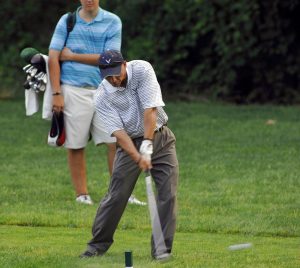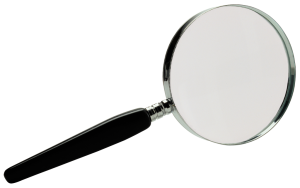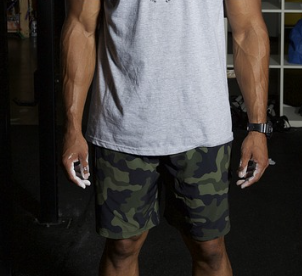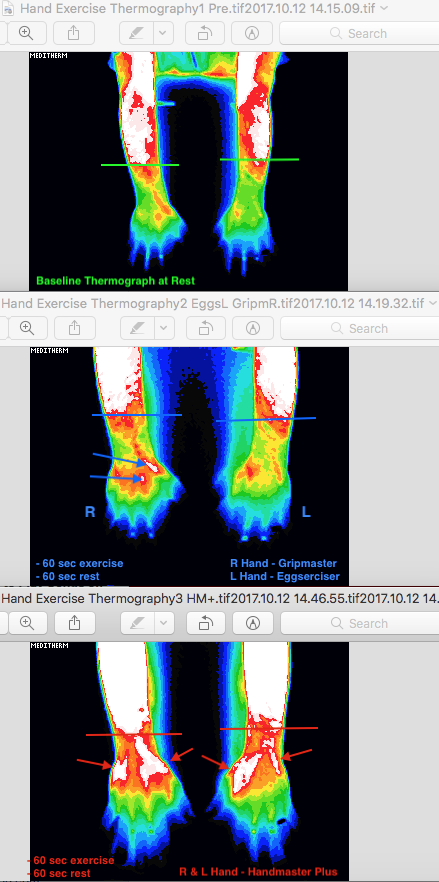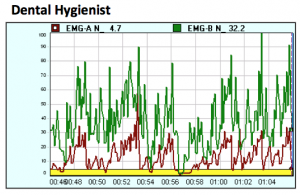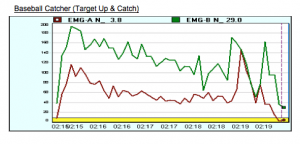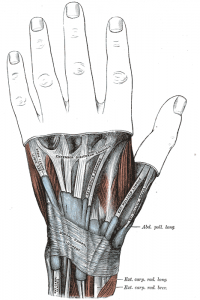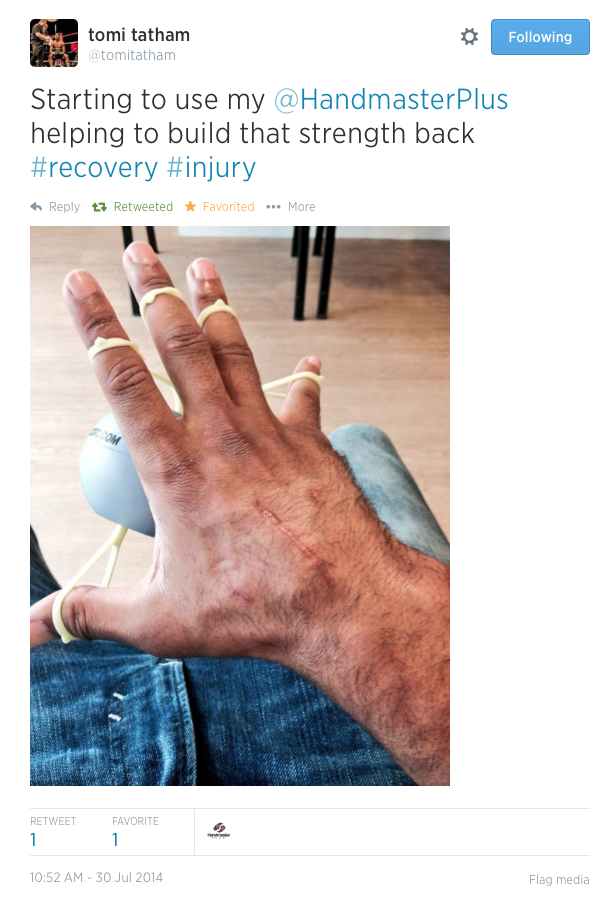Dr. Terry Zachary
Today’s blog in our ‘Understanding Hand Exercise & Grip Strength’ series is entitled ‘Part 5b – Active Grip Dilemmas at the Elbow.’ It further explores the interesting area of repetitive grip as it relates to the elbow.
Take this one super slow. It is a long one. Again, it will be NEW information to almost everyone, but will expand on our previous blog, ‘Part 5a – Grip Dilemmas at the Elbow,’ which examined grip dilemmas 1-3. Please review if necessary, as they relate directly.
Today’s blog isolates the 4 main categories of ‘ACTIVE’ grip dilemmas at the elbow. In other words, the discussion to follow asks the question” ‘What happens when ‘gripping PLUS stressful actions’ occur simultaneously?’
The examples of active grip dilemmas are everywhere and are directly causing diverse & costly elbow problems (and injury to the entire upper extremity). Elbow stability is especially at high risk in sports, music, hobby and in the workplace. And the result of these active elbow problems are becoming more apparent as an enormous baby boomer generation ages, and as our society becomes more grip, finger and thumb dependent with regard to cell phones, gaming & computers.
The author does not understand how the material to follow can be new material. But it is. And yet it is vital. It should become obvious, especially once a light is shined upon it and we begin to think for ourselves and explore our own grip habits.
Yes, as of today, it’s true… repetitive grip has been mostly overlooked. And rarely mentioned. And people continue to repetitively grip every day without a thought, both in their daily routines and in their fitness training. I’m hopeful that by the end of this blog you will recognize that the elbows are exposed so much to so much force in so many active pursuits. Something must be done to understand and prepare them better. Especially when gripping and action is simultaneously involved.
When an individual has been repetitively gripping in training or simply in performing their given daily activity (or both), the tissues of the elbow (ligament, tendon, muscle & fascia) are already shortened and already have poor blood flow. They are already at high risk for injury. They are already performing well below capacity, even if one is asymptomatic.
Keep in mind that whenever any joint, muscle, tendon, fascia or general body area is prepared poorly for activity and is then exposed to the stressors of real-world performance, the results are predictable: Weakness > Poor performance > Nuisance > Breakdown & Injury.
A simple progression. No one is immune to the laws of Nature.
Think of poor posture, for example. A person with poor posture feels normal, gets weaker, performs at a lower level, feels stiff, gets sore, and then, boom!… is debilitated.
Repetitive gripping is not unlike poor posture (in fact, VERY similar). The elbows are subsequently exposed to injury due to repetitive gripping the same way that the low back is exposed to injury because of poor posture. Both scenarios create primary imbalance and secondary mechanical stress.
There are 4 different and specific types of ‘active elbow stress’ that are notable in sports, music, hobby, gaming, computers and in the workplace. These are all exacerbated greatly by improper ‘squeeze-only’ grip training, or by no training at all (i.e. by constant daily repetitive gripping only).
You may identify one or many types of ‘active elbow stress’ in your own daily pursuit or pursuits. Once understood, the correlation between complete hand muscle training and elbow health and performance potential becomes crystal clear. The 18 hand muscles (9 open, 9 close the hand) are diverse and need to be healthy, balanced and have good blood flow. Otherwise, the rigors of gripping and performance stress will continue to win out in the form of limit, injury and debilitation.
Nature has designed the muscles of grip well. It is up to us to understand the principles well and live by them.
We know now that repetitive gripping leads to shortened finger flexor muscles and tendons AND static finger extensor muscles and tendons, as well as general elbow muscle imbalance. In other words, repetitive gripping creates health and performance challenges at both the inside and outside of the elbow.
So what happens at the elbow when we add activity to these overworked & oft underprepared areas? What happens when we add the stressors of performance (both physical and mental (yes, general tension)) to the elbow? Let’s look at some common scenarios and realize that balanced grip training and hand muscle health is essential in order to maximize performance and prevent injury.
Active Elbow Dilemma #4 – The Stress of ‘Gripping PLUS Striking’
Golf, tennis (i.e. all racquet sports), and hockey are three prime examples of additional stress being placed on the elbows during a striking motion… but there are many others. Chefs, butchers & drummers also share this activity. For explanation sake, let’s stick to some familiar sports to create easier visual examples in our minds.
Think first of contact during a golf shot (i.e. ball & ground) or a hockey slapshot (i.e. puck & ice). The ‘inside’ elbow of the trailing arm (the right arm for right-handers, left arm for left-handers) in both are placed in great stress. The same is true for the ‘inside’ elbow during the serve and forehand stroke in tennis. All place the elbow hugely at stress.
Additionally troubling and fascinating, is that (using surface electromyography (sEMG)) we can illustrate that grip pressure is at its highest during the actual strike in all 3 of these scenarios. The main finger flexor muscles (which cross the ‘inside’ or ‘medial’ joint of the elbow) are most fully engaged in grip AND most fully exposed to the greatest strike force resistance… BOTH at the same time.
This is a serious dilemma to the inside/medial (flexor) side of the elbow exposing it to regular repetitive micro- and macro-stress of the medial flexor tendons, muscles and ligaments. Micro- and macro-tearing that are both unnoticeable and noticeable in occur regularly during ‘gripping PLUS striking’ actions.
Advanced ligament damage can even be the result in more extreme situations (i.e. accidental tree root contact in golf) and more chronic cases (i.e. chronic tendon injury in professional golf, hockey or tennis athlete, etc.) at both the elbow and the wrist.
In all of these cases, the athlete must know to best prepare their hand muscle strength, health, circulation & balance to mitigate their exposure to these core chronic elbow imbalance risks. Repetitive grip training is not a solution. It is a problem.
Let’s also seriously consider the ‘outside’ elbow of the lead arm in golf and hockey (i.e. the left arm of a right-hander, right arm of a left-hander), and the outside elbow of the dominant arm during a backhand stroke in tennis. During the ball/puck strike, the main finger extensor muscles (that cross the ‘outside’ or ‘lateral’ elbow) are most fully engaged in grip AND most fully exposed to the greatest strike force resistance. Again, at the same time! Each strike applies stress to an already contracted and engaged outside elbow.
Just as a guitar string is easier to rip, cut or snap when it is overtightened, muscles & tendons so are more easily torn or injured when chronically tight and shortened.
‘Gripping PLUS striking’ actions on their own place stress at the elbow, but that risk is amplified exponentially when the tendons of the hand muscles that affect the elbow have been chronically shortened, made static, and/or are lacking healthy blood flow in our over five decades of ‘squeeze-only’ dominated hand exercise thinking.
Attention to detail must be made to be the highest priority when training the grip of anyone who regularly and inherently exposes their elbows to regular ‘gripping PLUS striking’ scenarios. The 9 muscles that open the hand and the 9 muscles that close the hand must be strong, healthy and balanced in order to accommodate this regular repetitive stress.
Active Elbow Dilemma #5 – The Stress of ‘Gripping PLUS Stretch’
The remainder of the elbow grip dilemma explanations (#5-7) may be somewhat more easy to comprehend now that ‘gripping PLUS striking’ has been discussed. For example, grip dilemma #6 at the elbow is similar, ‘gripping PLUS stretch.’
The best examples of the ‘gripping PLUS stretch’ type elbow stress are in throwers. We’ve all heard terms like thrower’s elbow, little league elbow and javelin elbow. These are throwing motions that create an inherent conflict between ‘grip’ and ‘separation’, two actions that are opposing.
Let me explain.
Throwing motions create a very dangerous valgus stress (i.e. an angled separation outward) risk for tendon and ligament injuries at the medial elbow. The elbow is essentially tractioned by stretch, yet the gripping action of the fingers is creating a contraction stress. These actions essentially oppose one another until the release of the ball or javelin in these examples. It’s a tug of war at the elbow before the throw.
This ‘gripping PLUS stretch’ exists in many instances without the release of the gripped item. Two examples are gymnastics (i.e. grips, bars & rings) and football tackling. Each can create stressful elbow moments that bring a great risk of injury to the elbows. The fingers contract across the elbow but the joint is being stretched. Yuck.
When hand muscles are trained improperly (i.e. traditional ‘squeeze-only’ training) or are not trained at all (i.e. most athletes in ‘gripping PLUS stretch’ sports regularly train biceps, triceps, shoulders, chest, back, and torso… all requiring grip for resistance) and lead to unopposed hand muscle imbalance, shortened tendons and muscles at the medial elbow.
Traction spurs at the medial elbow can occur with chronic elbow stress as the body’s way of stabilizing this unstable situation.
Best to prepare the elbow properly through balanced hand and arm exercise.
A further stretch dilemma occurs upon full release of a thrown item. The momentum of a baseball thrown by a pitcher or a javelin thrown or a football thrown creates a full follow through (release) at the lateral elbow that can cause stretch stress at the outside elbow.
Throwers face the potential for trouble everywhere… just before the throw… during the throw… after the throw. They MUST be trained properly. They must be in balance. They must have healthy blood flow to their elbow related ligament, tendons and muscles.
Otherwise, the results are predictable.
Active Elbow Dilemma #6 – The Stress of ‘Gripping PLUS Rotation’
Grip dilemma #6 at the elbow is ‘gripping PLUS rotation.’ Let’s again first offer some examples and next examine the problem.
Activities which require active grip plus rotation are mechanics, heavy duty mechanics, autobody mechanics, plumbers, painters, motorcyclists, jet-skiers/motocross, table tennis and tennis (spin hitters), assembly line (if twisting), check out cashiers in grocery stores, etc. These are common activities where gripping and rotating the forearm are combined.
Here we see a unique elbow stress. The individual will seem healthy, even super strong, and then suddenly become quite debilitated with elbow pain usually laterally, but sometimes medially.
The finger muscles and tendons (both extensors and flexors) are chronically engaged in repetitive grip, which we know causes unhealthy shortening and poor blood flow at the inside and outside elbow. To that, add that the individual is trying to create rotation at an elbow that isn’t (via habitual repetitive gripping) able to move maximally.
Supinator muscles, that attach at the lateral epicondyle of the humerus as well as at the forearm, become shortened when forearm rotational tasks are habitually into external rotation. Pronator teres muscle, that attaches above the medial epicondyle, becomes shortened in habitual forearm internal rotation tasks.
‘Gripping PLUS rotation’ isn’t a strike force dilemma, but a chronic request for forearm rotation in performing an activity while also in grip, though the finger flexors and extensors that cross the elbow stay shortened. Another dilemma.
Additionally, as mentioned, these forearm rotation activities, on their own are rarely in a perfect balance of rotation (i.e. equal supination (external rotation) and equal pronation (internal rotation)). The soft tissue elbow structures in these ‘gripping PLUS rotation’ activities are littered with chronic imbalance.
For example, the motocross athlete would repetitively grasp, wrist extend AND pronate in order to throttle the bike. The mechanic would grip the wrench and twist often with great pressure to loosen a bolt or screw. The grocery cashier grips and rotates to swipe to reads the bar code.
The bottom line is that there is forceful or chronic repetitive rotation required against an elbow that is more and more immobilized because the finger muscles and tendons contract across the elbow chronically in gripping… but are never trained for balance nor blood flow.
Properly balanced grip training is vital for these individuals – as all other active grip situations – even though they may seem strong for a long time. Once the imbalance is chronic, trouble may be around the corner at any second.
Active Dilemma #7 – The Stress of ‘Gripping PLUS Repetition’
If you are following well so far, awesome! Way to go!
Again, this is new information to most. Sometimes it takes time to create new room in our brain. You should process these concepts yourself and see if it makes sense in your activity or expertise. Read it over a few times if needed. I guarantee it does make sense. We have the sEMG (surface electromyography) studies to prove it.
New ideas such as simple full range of motion hand exercise may have difficult births, even if sensible.
Grip training principles and hand muscle balance must be understood deeply if we intend to create solutions and have strong, stable, healthy elbows.
And now we examine a problem that many identify with. Like ‘gripping PLUS rotation’ this type of active grip dilemma is insidious… until it is obvious. Until then, it is also subtle and disregarded.
The final main elbow dilemma is ‘Gripping PLUS repetition’ and is most probably inherent as a key factor in all other grip dilemmas. ‘Gripping PLUS repetition’ requires attention on its own because of its relation to many commonly heard conditions which (for some reason) have never been described in relation to their underlying cause.
The best examples to offer in an effort to illustrate this problem is musicians, workplace injuries, and weightlifters. For the purpose of illustration, I will specifically use guitar players (as musicians), dental hygienists (as workplace) and a biceps exercise (in weightlifting/fitness).
In my experience, they are three of the most chronically debilitating repetition activities I’ve studied and been involved with. And in each, there is very incomplete knowledge and education available for users to peruse.
Guitar & music stores are still filled with ‘5-decade old’ default hand exercisers… ‘squeeze-only’ grippers, whether spring-loaded or coiled. They are still very popular. Somehow.
The music marketplace (like all markets) cares about what sells, and these ‘squeeze-only’ items sell. They sell because of an archaic customer belief about the mechanics of finger grip & hand strength training.
On the surface, ‘squeeze-only’ devices appear to work well because the user feels (and is) stronger and faster in the short term, the same way a young boy is strong who only strengthens their chest and biceps (to impress the young girls) and forgets about training their back and triceps for strength AND balance.
But eventually, this imbalanced approach will show its weakness. Slowly. Subtly. The body can absorb some imbalance, but eventually, there is a tipping point.
And when problems do start, who would blame a hand exercise that has become a familiar and celebrated for its help?
I’ve worked directly with many musicians including some from very famous and accomplished bands. The guitarist of one Rock and Roll Hall of Famer was riddled with hand arthritis, very common in older guitar players. Another has fingers stuck in a repetitive grip related flexion malposition. One Grand Ole Opry bassist struggled with circulation and resultant cramping, especially during performances.
All examples are very common in musicians, especially as they age and ignore fundamental balance and blood flow principles.
If repetitive gripping worked well, these career musicians would be in great shape. But they are not. And the older they get, the more these imbalances will add up and worsen the symptoms. They then most often turn to pharmaceutical drugs to numb the pain, drugs that have nothing to do with what is causing the situation. And they have supposedly been well advised. It is ludicrous and ignorant. It is the norm. Ask an old musician.
When musicians are young, their body adapts much better and these imbalances, though present, remain asymptomatic. They don’t know how strong, fast and stable they could be because they don’t hurt or hurt enough. It is all under the radar and can only be illustrated by pain point mapping and muscle testing.
The music market is in need of health and fitness education and leadership. Musicians are in need of balance. And the world needs music.
At the elbow, ‘Gripping PLUS repetition’ riddle most musicians with subtle and not so subtle imbalance conditions. Tennis elbow (lateral epicondylitis) is ultra-common and is almost a given (i.e. only depends ‘how bad?’) for all accomplished musicians. Medial epicondylitis is also common because of repetitive wrist and finger flexion.
A lesser known, but common condition among guitarists, occurs at the inside and back of the elbow and is known as cubital tunnel syndrome.
Cubital tunnel syndrome is a prime example of ‘gripping PLUS repetition’ The combination of repetitive shoulder abduction, elbow, wrist, and finger flexion, plus forearm rotation of the fretting hand leads to a habitual decrease in the height of a space called the cubital tunnel. This change in space interferes with the passage of the ulnar nerve, causing weakness, numbness, and pain. Cubital tunnel syndrome can incapacitate a guitar player.
The wrist flexor muscle on the inside of the elbow can also trap the ulnar nerve. Primary imbalance. Secondary stress. A common theme of ‘gripping PLUS repetition.’
The musician must effort to understand their imbalance and offset the repetitive nature of their pursuit in order to keep the balance of the hand, wrist and forearm muscles well maintained (as well as the rest of the arms, shoulders, and spine). To do so requires educational leadership and regular, disciplined, balanced training.
Workplaces around the world are also strewn with ‘gripping PLUS repetition’ dilemmas at the elbow, no more so than dental hygienists.
Dental hygienists 1) handle tools that are small in nature (creating increased hand muscle output for grip), 2) tools are often vibrating (increasing grip demand), 3) grip for long periods without a break, and 4) the position of their hands are mostly palm-down (something we will discuss at length in a later blog) creating extra stress to the grip and elbow.
As a result, dental hygienists are subject to chronic ‘gripping PLUS repetition’ elbow imbalance conditions, one of the most invasive grip occupations we have studied thus far.
Ergonomic exercises should be presented to all dental hygienists during their training. None are immune to this dilemma at the elbow.
Let’s next examine the weightlifter/fitness enthusiast, another huge but undetected problem due to lack of attention on grip mechanics. If you are a person who goes to the gym, this is for you,
First, please think of how many free weights, kettle balls or weight machines require gripping to hold a weight or a weight machine handle to create muscle resistance? A lot, right?
And think how often we hold that weight or handle with our hands fully open compared to with hands fully closed…? A facetious thought indeed, but a thought that must be considered. We know from ‘Part 3 – The Kinetic Chain of Grip’ that the muscles that open the hand are as important in gripping as the muscles that close the hand. Still, weightlifters and fitness enthusiasts only train hand squeezing.
The result is what we are calling the appearance of lego-hands, hands that do not hang naturally or neutrally. Hands that have been trained and held into a curled flex. Hands that, in essence, have bad posture.
Thus, finger extensor muscles on every weightlifter and every fitness buff that enters and leaves a gym lack a solution for strengthening the 9 muscles that open the hand. 9 muscles that are vital. 9 muscles that Nature, in all of its wisdom, supplied. Completely ignored. It has been an unpardonable omission in fitness. This must change.
There exists commonly in weightlifting a famous condition called radial tunnel syndrome where the radial nerve gets caught between the supinator muscle heads, especially during heavy repetitive biceps curl exercises with free weight dumbbells (i.e. chronic grip PLUS elbow flexion PLUS supination).
Of course, ‘gripping PLUS repetition’ exists in so many other occupations, sports, musical pursuits, and in gaming, hobbies & computers. Hand muscle training and balance is still a new idea that has vast applications to the health and performance of so many.
In our modern society, elbow dilemmas are nearly everywhere because repetitive gripping is nearly everywhere. Our first step is to understand these elbow dilemmas and take them seriously. Only then can we affect widespread change.
We are hoping now that you will recognize the various active grip dilemmas at the elbow and recognize where ‘gripping PLUS striking,’ ‘gripping PLUS stretch,’ ‘gripping PLUS rotation,’ and ‘gripping PLUS repetition’ is at play, and effort to prepare the body properly for these activities.
Only then can we hope to perform and prevent elbow injury maximally.
In our next blog, we will address why most grip dilemmas at the elbow also occur at the wrist.
Don’t miss it!
Dr. Terry Zachary is an advocate for proper and complete hand exercise & grip strength training in sports, music, the workplace, modern computer, electronics/gaming/esports, therapy/rehab/wellness, and hobby. Dr. Zachary discovered that repetitive gripping imbalances have gone under the radar as a cause of muscle imbalance, weakness, poor blood flow, and poor lymph drainage for over 5 decades. He developed Handmaster Plus to provide the world with fast, easy and complete hand training to create maximum strength, balance, performance, and overall health. The result is healthy, stable fingers, thumbs, wrists, carpal tunnels, forearms, and elbows… and healthier lives.
Dr. Zachary can be reached at terry@doczac.com. For information on Handmaster Plus, visit www.handmasterplus.com



